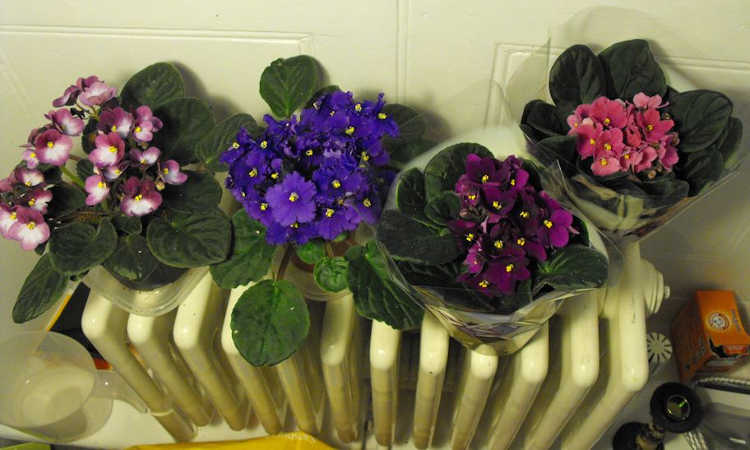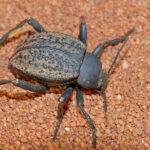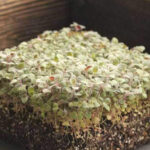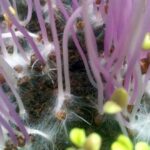African violets, also known as Saintpaulias, are associated with motherhood, and are a traditional gift to Mom for Mother’s Day. They’re also popular for Valentine’s Day and for Easter.
But what are African violets? Are there different species or varieties, and what might those be? Are they all blue or purple?
Is there a best way to take care of African violets? Are these plants best indoors or outdoors, and what’s the differences in their care?
Let’s find out!
- Neem Oil
- Safer Brand Yard & Garden Spray
- Monterey BT
- Botanigard ES
- Garden Safe Slug & Snail Bait
- Beneficial Nematodes
- Bonide Copper Fungicide
African Violet Overview
 An unofficial African violet cultivar, ‘Haggen’. Source: Geek2Nurse
An unofficial African violet cultivar, ‘Haggen’. Source: Geek2Nurse| Common Name(s) | African violets,saintpaulias, plus a very wide number of cultivar names |
| Scientific Name | Saintpaulia ionantha, Saintpaulia goetzeana, Saintpaulia inconspicua, Saintpaulia pusilla, Saintpaulia shumensis, Saintpaulia teitensis, Saintpaulia tongwensis, Saintpaulia ulugurensis, Saintpaulia watkinsii |
| Family | Gesneriaceae |
| Origin | Southern Africa |
| Height | 3-6” |
| Light | Bright, indirect light or grow light |
| Water | Tepid water, just enough to dampen potting soil. Avoid leaving water on leaves. |
| Temperature | 65-75 degrees Fahrenheit |
| Humidity | 60% or less, prefers the 40-50% range |
| Soil | Extremely well-draining mix of peat moss, perlite, & vermiculite |
| Fertilizer | Balanced fertilizer for overall plant care, higher phosphorous for flowering |
| Propagation | From seed, leaf cuttings, or division. Can occasionally produce runners that self-root. |
| Pests | Thrips, cockroaches, some caterpillar species (orange-striped oakworm, salt marsh caterpillar, cabbage looper), aphids, whiteflies, mites (cyclamen mite, broad mite, spider mite), scale insects, mealybugs, pill bugs, slugs, collembola (springtails), fungus gnats. Also susceptible to powdery mildew, phytophthora, pythium, rhizoctona, botrytis cinerea, and erwinia. |
Types of African Violets
Native to eastern tropical Africa, the African violet gets its common name from the superficial similarities it has to true violets or violas. In reality, these are all Saintpaulias, but from there it becomes a tangled mass of confusion.
The African Violet Society of America, the largest group dedicated to a single plant type in the world, has more than 16,000 cultivars in their database.
Some of these look virtually identical to one another, and there is much confusion on the different varieties.
The Primary African Violet, Saintpaulia Ionantha
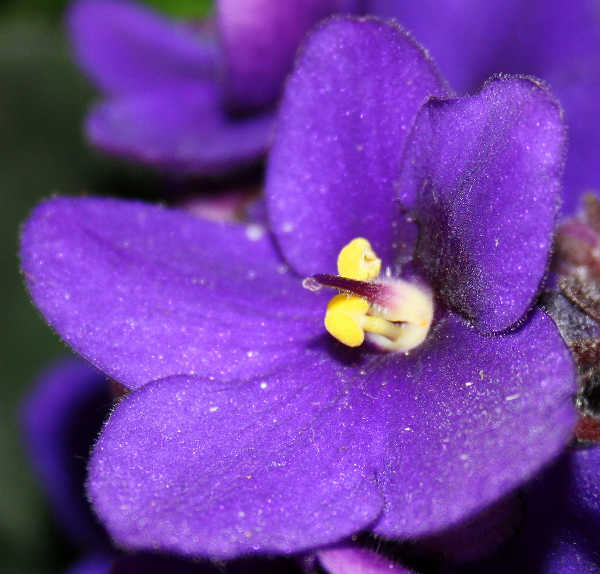 Saintpaulia ionantha. Source: Lauren Tucker
Saintpaulia ionantha. Source: Lauren TuckerAt one point, there were 20 recognized species of saintpaulias. However, most of those have been reclassified as Saintpaulia ionantha, as they were deemed to be too similar to the ionantha species.
As of 2009, there were nine species, eight subspecies, and two varieties of Saintpaulias established.
What you need to know is that the vast majority of African violets are derived from Saintpaulia ionantha. This species is where hybrids get most of their genetics, and makes up most of the “standard” sized African violets available today.
From there, they divide into subspecies. Velutina, grotei, pendula, nitida, occidentalis, grandifolia, orbicularis, and rupicola are known subspecies of Saintpaulia ionantha. It divides further into varieties and individual cultivars at that point.
Other Saintpaulia Species
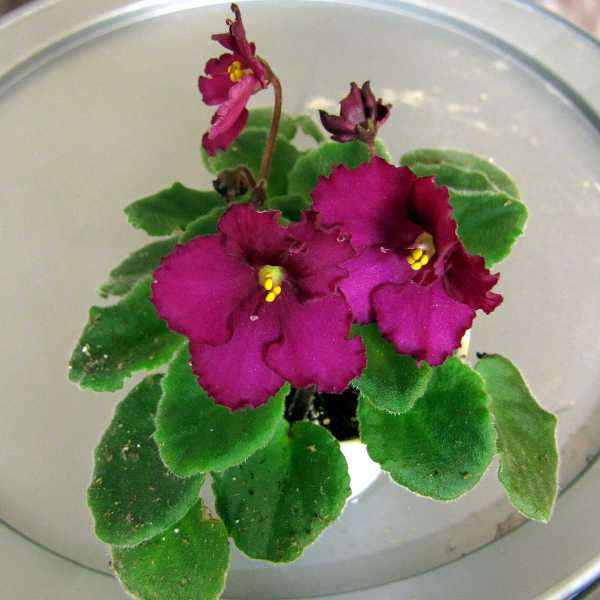 The ‘Optimara Little Maya’ cultivar of African violet. Source: khufram
The ‘Optimara Little Maya’ cultivar of African violet. Source: khuframBut don’t forget, while Saintpaulia ionantha is the most prevalent and used most for hybridization, there are still other species of African violets out there!
Other species of African violets include:
- Saintpaulia goetzeana
- Saintpaulia inconspicua
- Saintpaulia pusilla
- Saintpaulia shumensis
- Saintpaulia teitensis
- Saintpaulia tongwensis
- Saintpaulia ulugurensis
- Saintpaulia watkinsii.
Cultivars And More
 The ‘Ness Red Mini Soda’ cultivar of African violets. Source: MJI Photos
The ‘Ness Red Mini Soda’ cultivar of African violets. Source: MJI PhotosBetween those less-known species and Saintpaulia ionantha, some 16,000+ cultivars of African violets have been derived, and many consider that an underestimation. There are new cultivars found regularly.
There’s no plausible way to list all the various cultivars that exist. Even the International Cultivar Registration Authority can’t seem to keep up with the ever-growing list!
What they all have in common is slightly fuzzy leaves in a rounded shape, and the capability to produce flowers which are reminiscent of the appearance of true violets.
However, wild cultivars have spawned multicolored leaves, flowers that look like they’re edged with a different color or spattered with paint, streaks of color, and nearly every imaginable shade of flower or leaf.
Often, these are crazy cross-breeds that have developed from mixing cultivars until something truly spectacular emerges.
No matter which African violet you decide to grow, one thing remains true: they’re all cared for quite similarly. Let’s focus on the care of these stunning little plants now!
What You Need To Grow African Violets
 The ‘Taffeta Blue’ cultivar of African violets. Source: Geek2Nurse
The ‘Taffeta Blue’ cultivar of African violets. Source: Geek2NurseInitially, your African violets may seem a bit picky. In reality, they’re just quite specific as to what they need. If you provide these things, they will blossom and grow quite readily.
Light Requirements
Lighting your African violets can be a bit tricky until you’ve found the right location. The African violet prefers at least 10-12 hours of bright, indirect light each day, and at least 8 hours of darkness.
If growing your plants outdoors, you will need to grow them in the shade. Too much direct sunlight can cause leaf scorch, which is like the plant’s version of a sunburn. It creates patches of brown on the leaves, causes the leaves to curl downward, and can force variegated-color leaves to turn entirely green.
Too little sunlight can also be a problem. This will slow or stop flowering and cause the plant’s leaves to yellow. It may begin to develop elongated leaves or stems to try to stretch out and gain more sunlight.
Growers should pay attention to how much light their African violets receive. It’s important to turn indoor plants regularly to allow for all parts of the plant to receive their indirect lighting.
Outdoor plants may need an added reflector to help redirect the light to darker portions of the plant. Something as simple as a white-painted fence behind the plant may provide enough reflection to keep the plant healthy.
Indoor placement is important too. A window with western or southern exposure should provide a good amount of light throughout the day. Again, try to avoid direct sunlight to prevent leaf scorching.
Growing African Violets With Grow Lights
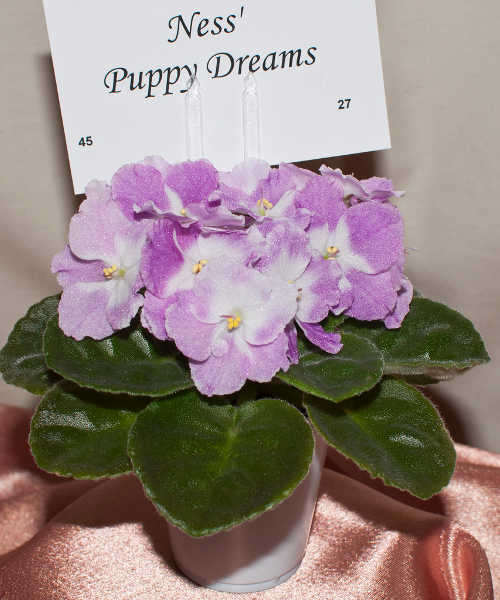 The ‘Ness Puppy Dreams’ cultivar of African violet. Source: MJI Photos
The ‘Ness Puppy Dreams’ cultivar of African violet. Source: MJI PhotosIt’s much easier for many people to grow this plant indoors with grow lights. This allows you to control the light which your plant receives to maximize blossoming and healthy growth.
Using a grow light is relatively simple, provided that you have the best one for your needs. Optimally, you will select a grow light that provides both red and blue lighting. Red light is required to produce flowering, and blue lighting is absolutely essential to photosynthesis.
To be absolutely certain you’ve got the right color range, you can opt to utilize full-spectrum LEDs. One of these will provide a wide variety of shades of light to help stimulate plant growth.
I personally like the adaptability of the Viparspectra lights, as you can opt to focus on either flowering or plant growth with a simple flip of the switch. You can also choose between different wattages depending on the size of your growing space, and there’s other features like reflector shields or dimmers available.
Be careful to avoid placing your light fixture too close to the plants. If it’s too close, you can experience leaf-scorch conditions that are similar to when the plant gets too much sunlight.
Similarly, some varieties of African violets are sensitive enough to experience leaf blanching from grow lights. The blanched leaves will appear distinctly lighter and may have a pinkish cast.
These saintpaulias should be grown without grow lights in alternative bright, indirectly-lit conditions.
Temperature
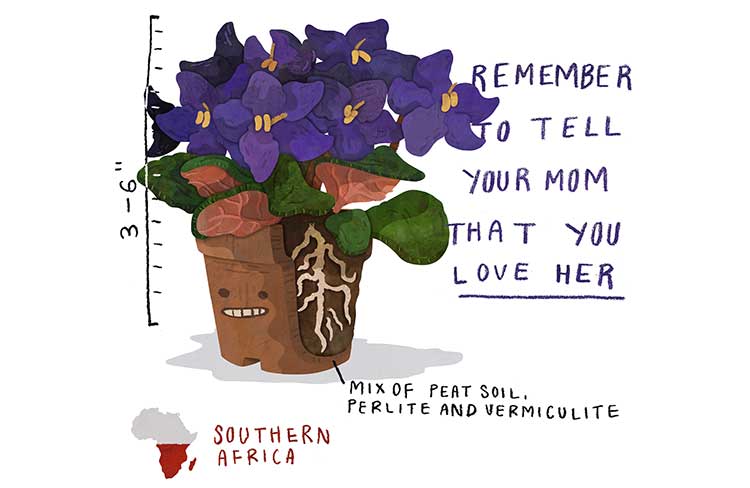 Quick-care guide for the African violet. Custom art for Epic Gardening by Seb Westcott.
Quick-care guide for the African violet. Custom art for Epic Gardening by Seb Westcott.African violets prefer a temperature range between 65-75 degrees for optimal blooming and growth.
These plants are not very cold-hardy. If conditions drop below 60, your plant may not bloom or may experience greatly-slowed growth. However, temperatures below 50 degrees can be fatal to your plant.
A cold frame is necessary to keep the temperature closer to 60+ during the winter. Alternately, bring your plants indoors to overwinter them.
Hotter conditions, between 75-90 degrees, can be survived for short periods of time. Ensure your plants are watered and fertilized and that they have adequate air circulation during these hotter times. Try to provide them cooler temperatures whenever possible.
Often, people will grow their African violets indoors simply because the average home is often kept in the optimal temperature range. This can really benefit your plant in a number of ways.
Water
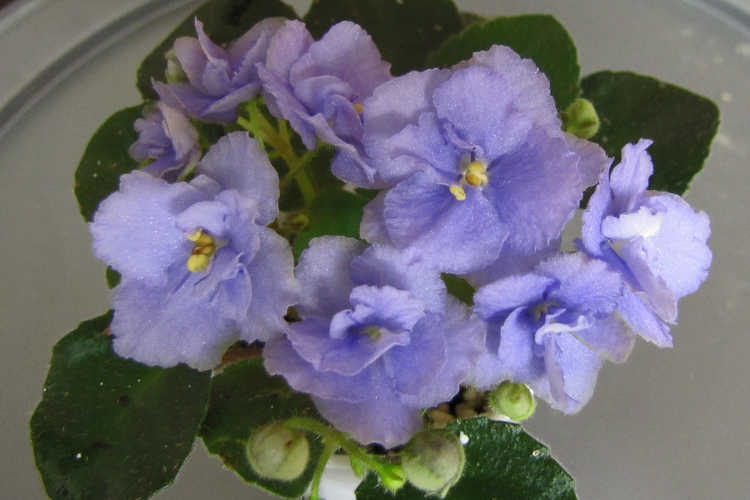 The ‘Super Boy’ cultivar of African violets. Source: khufram
The ‘Super Boy’ cultivar of African violets. Source: khuframProviding water for your African violets is obvious, but they’re quite specific on what they want in terms of water.
Tepid water, neither cold nor hot, is best to use as it won’t shock the plant’s sensitive root structure. Water thoroughly overtop of the growing medium, allowing any excess water to drain through and flow freely away. Only leave as much water as the medium itself will hold for best growth.
Try to avoid wetting the leaves directly, especially if it will be exposed to sunlight or grow lights immediately afterward. Not only are saintpaulias somewhat susceptible to fungal issues, but a water droplet on a leaf can cause scorching if it’s exposed to direct light for too long. Blot off the leaves to remove excess moisture.
You can water from the bottom of the plant by setting it into a tray of water for an hour, then removing it. However, every third to fourth watering, you should water it from the top as directed above. This will rinse any extra salt deposits out of the soil.
It’s best to err on the side of less water if you’re not sure, and to only water when the soil is dry to the touch.
Soil
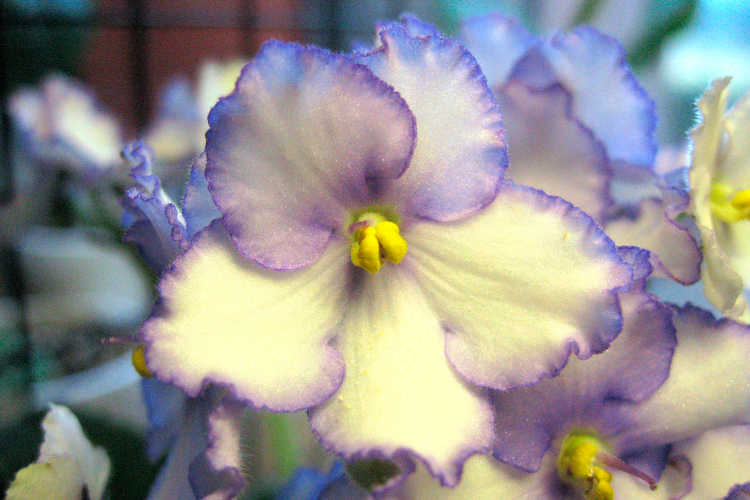 African violet cultivar ‘Optimara Alaska’. Source: Geek2Nurse
African violet cultivar ‘Optimara Alaska’. Source: Geek2NurseFor Saintpaulias, having the right potting mix is a key element to their continued growth. Unlike many other plants, these grow extremely well in a soilless mix if it’s prepared properly.
There’s some debate as to the ratios, but the vast majority of African violet mixes contain three ingredients: peat, perlite, and vermiculite. In addition, the pH of your mix should be in the 6.4-6.9 range for best growth.
The African Violet Society of America offers this recipe for a soilless mix, using a one-pound coffee can as the measure:
- 3 parts sphagnum peat moss
- 2 parts vermiculite
- 1 part perlite
- 1/4 part ground charcoal
- 2 tablespoons dolomite lime (also called horticultural lime)
- 1 tablespoon bonemeal
- 1 tablespoon superphosphate
This recipe produces a slightly acidic soilless potting mix which your violets should greatly appreciate. There’s a reasonable amount of nutrients in it initially, but you’ll need to regularly fertilize.
Don’t want to make your own? You can always purchase a pre-made potting mix such as this Espoma organic mix for African violets. However, making your own really helps you to identify what works best for your specific plants and allows you to adjust the blend as needed.
If you are going to plant directly in the ground, you need to first ensure that the soil itself is going to be extremely well-draining.
I recommend digging a larger hole, amending the bottom with extra perlite to help provide drainage, and then filling the hole with this potting mix. This ensures that the plant has its preferred growing medium at hand.
People who have hard clay soils that don’t drain well should probably opt for growing in containers rather than in the ground.
African Violet Care
 The ‘Optimara Little Azurite’ cultivar of African violets. Source: khufram
The ‘Optimara Little Azurite’ cultivar of African violets. Source: khuframOnce you’ve got your plant established in its pot or bed, and you’ve learned to handle its basic requirements, there’s a bit more yet to learn. Here you’ll find specific care tips designed to bring out the best in your African violets.
Fertilizer
Before you fertilize, you need to be sure your plant is not showing any signs of over-watering or under-watering. If it is, correct the problem and maintain the plant for a week or two at a healthy range before fertilizing.
There are two schools of thought in terms of fertilizer for African violets.
I tend to be in the balanced fertilizer camp, and will use a water-soluble balanced fertilizer in the 10-10-10 or 20-20-20 range. Mix according to its package directions, and then apply that to the soil (but never the foliage of the plant directly).
The other popular fertilizer method is a high-phosphorous variety that encourages rapid flowering. A 15-30-15 will encourage your plant to go crazy with the blooms, and you’ll get tons of color from it.
Check the package directions on your fertilizer closely to see what they recommend in terms of frequency. If your fertilizer is meant for monthly application, you may be able to fertilize weekly by simply diluting it to a quarter-strength solution. Similarly, if you want to fertilize every two weeks, you can dilute it down by half of its recommended amount.
You can over-fertilize African violets. If your plant begins forming orangish crystals clinging to the plant hairs at the crown, are experiencing leaf tip-burn, or the leaves or stems have lesions where they rest against your pot, you’re using too much fertilizer.
Leaves which wilt or brown and have a soft jelly-like consistency, or brittle or cracked leaves, can also be signs of overfertilization. These usually happen after an extended period of too regular fertilization, and may take a while to recover. Avoid adding fertilizer for a while.
Propagation From Seed
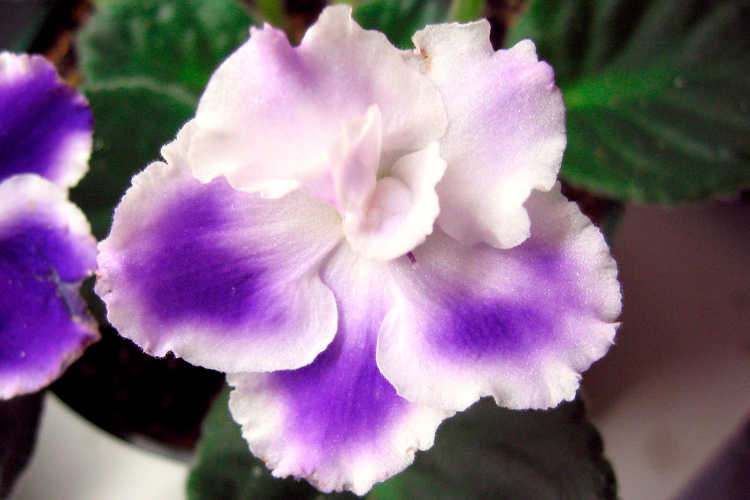 The ‘Rhapsodie Cora’ cultivar of African violets. Source: Geek2Nurse
The ‘Rhapsodie Cora’ cultivar of African violets. Source: Geek2NurseAfrican violets can be grown from seed, leaf cuttings, or division. They can also put out sucker shoots on their own (especially the chimera varieties), but most are done from seed, cuttings, or division.
While finding African violet seeds can be tricky, what’s trickier is getting them to germinate properly. The seeds of saintpaulias tend to be very tiny and hard to spread, plus they prefer a very specific medium to germinate.
If you’re trying to grow African violets from seed, be forewarned that they may not look identical to their parent plant.
Use peat moss as a growing media and thoroughly moisten it, then lightly sprinkle your seed across the surface. Cover the pot with plastic wrap and keep it in bright, indirect sunlight. Use a misting bottle to water it when the peat begins to dry.
Propagation From Leaf Cuttings
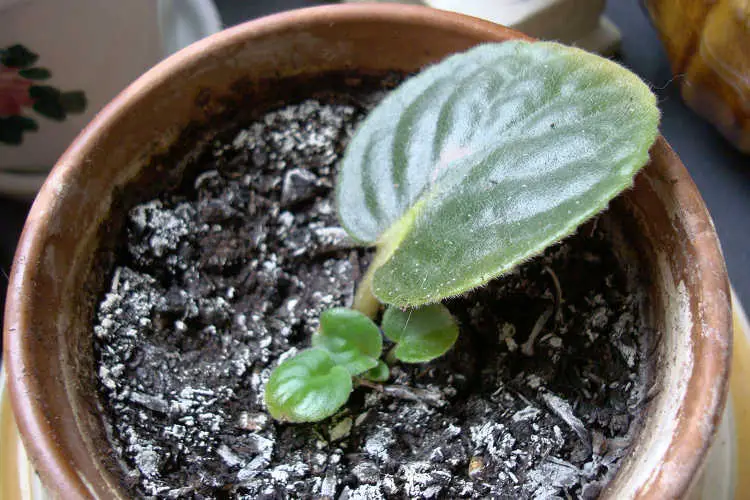 A leaf cutting developing new growth. Source: Satrina0
A leaf cutting developing new growth. Source: Satrina0Propagating from leaf cuttings is the easiest method, and the best way to ensure you’ll have a clone of your parent plant.
Begin by selecting young, healthy leaves which show no signs of any damage. These will be what your new plant sprouts from, so it’s essential to select the best leaves your plant has to offer.
You will need to trim through the leaf stem at about a 45-degree angle with the cut side facing upward. You can also remove some of the top of the leaf itself, but no more than 1/3 to 1/2 of the leaf should be removed.
Place your cuttings into a small pot filled with African violet potting mix. You can opt to add extra perlite to this if you’d like to help ensure it’s light and drains readily. Moisten the potting mix once you’ve placed your leaf starts into it, and put it under a plastic dome.
Your young plants will come up from the cut end of the leaf stem.
For a visual of this process, check out this video, which shows exactly how it’s done!
Propagation By Division
If you’ve got lots of leaf starts in a single container, or multiple plants that have grown together, you’ll eventually want to divide them. If you’re careful, you can manage to gain multiple separated plants this way.
African violet stems tend to be quite fragile, so you will likely break some during this process. Don’t panic, though. Most of the weakest ones are likely older, and will need to come off anyway.
Remove your saintpaulia from its pot and examine it closely. You’ll need to identify the individual crowns or rosettes which make up each plant. Once you’ve established where they are, gently remove some of the growing medium and carefully try to pull them apart. Be sure to keep roots on each individual crown.
Once you’ve separated the crowns, you can pick between them to replant the strongest-looking ones, or you can simply replant them all. Weaker ones or those with no roots attached may die off once separated. Robust plants should tolerate this process fairly well.
Repotting
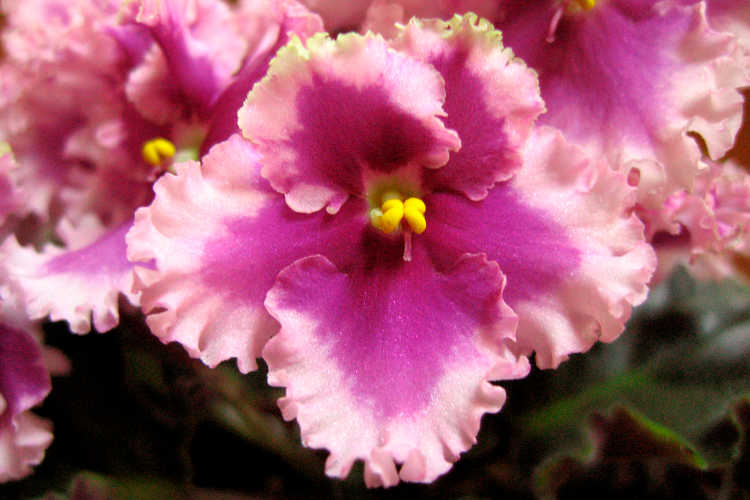 ‘Optimara EverLove’, a cultivar of African violets. Source: Geek2Nurse
‘Optimara EverLove’, a cultivar of African violets. Source: Geek2NurseMost African violets like to be a bit rootbound to flower. However, eventually they will outgrow their pot. At this point, you can opt to divide your plant, or simply replant in a larger pot.
To replant the whole plant, select a pot that’s just barely bigger than your existing pot. Gently remove your plant from its old pot and knock off most of the older potting mix, leaving just what the roots are holding onto. Put new potting mix into the new pot, and settle your plant in place.
If your plant has gotten very overgrown and you don’t want to divide it, or it’s started to develop root rot, a more radical procedure can be done during repotting. The video below will walk you through the process. This can save failing plants, so it’s worth knowing!
Pruning
African violets are some of the easiest plants to prune, as it doesn’t require any special equipment or fancy techniques!
It’s advisable to prune when your lower, older leaves are beginning to fade. Simply grasp the leaf stem and bend it to the side. It should break off easily. You’ll likely be removing 2-3 leaves per month from the average indoor plant.
Also important is removing spent flowers. As the flowers begin to fade, they can simply be gently plucked out with your fingertips. This encourages more flower development and keeps the plant healthy.
Problems
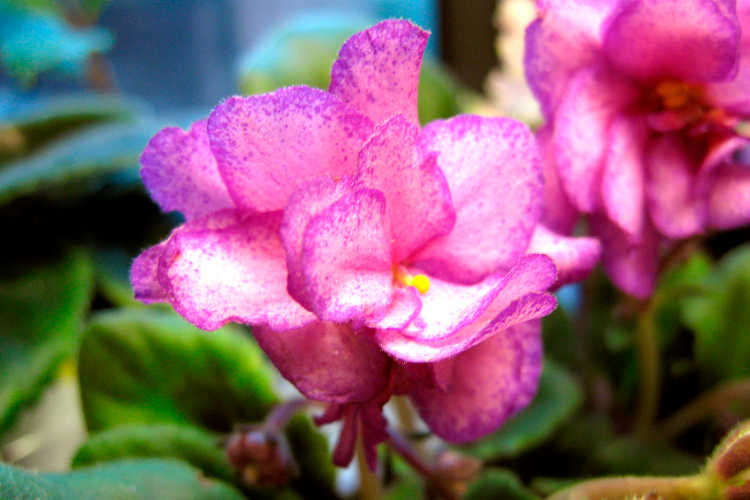 The ‘Laughing Anna’ cultivar of African violets. Source: Geek2Nurse
The ‘Laughing Anna’ cultivar of African violets. Source: Geek2NurseProvided that you’ve given your African violets what they need to grow, you shouldn’t have too many problems.
However, there are pests and diseases which can develop on these plants. It’s important to know how to handle them in advance so you can keep a watchful eye out for them.
With proper care, you shouldn’t see any of these, but just in case you do, here’s how to handle them all!
Spraying Neem Oil Or Other Fungicides/Insecticides On African Violets
You’ll notice in the pest and disease sections that I mention neem oil a LOT. There’s a reason for this. Not only is it a light pesticide and a light fungicide, but it also tends to be a preventative for a lot of plant problems, and it’s organic.
However, you don’t want too much on your African violets, because a buildup of neem oil can cause leaf scorching. With other fungicides or insecticides, it can also cause a buildup and may harm your plant. It’s important to have a light hand and a super-fine mist when handling African violets.
This video will show you a good technique to thoroughly spray your plants without going overboard. Doing this every week should eliminate an awful lot of pest or disease risks.
Chewing Pests
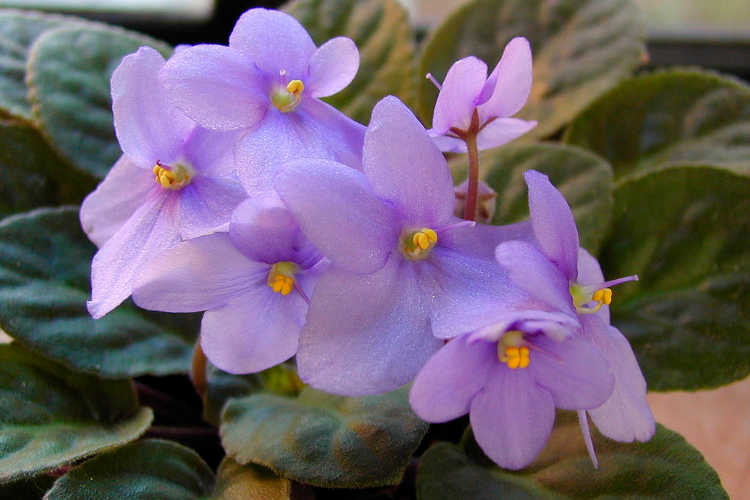 The ‘Rhapsodie Stephanie’ cultivar of African violets. Source: Geek2Nurse
The ‘Rhapsodie Stephanie’ cultivar of African violets. Source: Geek2NurseThrips love African violet pollen, and will happily eat that as well as visibly abrade the flowers and leaves. These pests can also cause sucking damage, causing your plants to wilt.
Both neem oil and pyrethrin sprays such as Safer Brand Yard & Garden Spray are effective at eliminating thrips. Neem oil helps keep them from coming back, and works as a great preventative.
Strange as it may seem, cockroaches are a common pest of African violets. They will devour the flowers entirely, making it seem as though your plant never blooms, but can also eat holes through the leaves. And, as they strike at night, you may never see them at all.
Placing roach bait or traps near your plants is the best solution for these annoying household pests. You can use commercial roach sprays as well, but never directly on your African violets. You can also use borax powder to create a ring around your indoor plant that the roaches will hesitate to cross.
A trio of caterpillars consider African violets to be a target based on opportunity, but prefer other foods.
The orange-striped oakworm (Anisota senatoria) will nibble on leaves if it has the chance, but prefers oak trees.
Similarly, the woolly bear or salt marsh caterpillar (Estigmene acrea) will munch on African violets, but far prefers a number of food crops including cabbage, peas, potatoes, maize and a number of others.
And finally, the cabbage looper is quite willing to munch through your violet leaves if given the chance. It might prefer food crops as well, but an African violet will definitely suffice!
All of these caterpillars can be hand-picked off your plants. However, if necessary, a BT spray such as Monterey BT is effective at killing off the caterpillars. Neem oil will smother any eggs that may have been laid on your plants. Keeping moths away should keep them from returning.
Sucking Pests
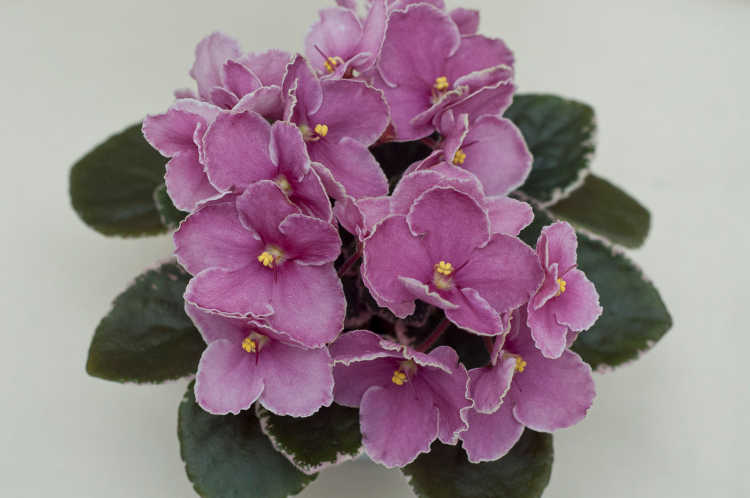 African violet, ‘Ness Pixie Grin’ cultivar. Source: MJI Photos
African violet, ‘Ness Pixie Grin’ cultivar. Source: MJI PhotosAs with so many other plants with moisture-filled leaves, aphids are a risk. So too are whiteflies. Both of these insects will suck the life right out of your African violets, causing them to yellow and wilt.
Use neem oil to spray all plant surfaces to kill off these two pests and keep them from returning.
Mites are a risk on African violets.
The cyclamen mite (Phytonemus pallidus) is extremely tiny and invisible to the naked eye. It causes streaking and blotching on leaves and can prevent flowering.
Broad mites (Polyphagotarsonemus latus) are also effectively invisible and are common in greenhouse situations. These will stunt the plant’s growth and cause the leaves and buds to become deformed.
Finally, the spider mite (Tetranychus spp.) is a super-common pest on houseplants and in greenhouses. It will wreak havoc on your African violets as well.
Thankfully, all three of these mites can be eliminated with neem oil, which is really a great multipurpose product when growing African violets.
Scale insects in general are a problem on African violets, although it seems to be mostly limited to armored scale or mealybugs. The armored scale will form on the undersides of leaves and can be troublesome to remove.
Two forms of mealybugs are notable problems for African violets. One, the Pritchard’s mealybug (Rhizoecus pritchardi), is probably the worst scale-type insect for the Saintpaulia species, as it specifically targets these plants. The other is the related ground mealybug (Rhizoecus falcifer).
Both of these mealybugs tend to attack the roots or the base of the crown. They can be difficult to identify because they tend to remain in the soil, leaving cottony white masses around plant roots. The only time they’re likely to come to the surface is after a thorough watering.
Using a mycoinsecticide as a soil drench around your plants should eliminate most root mealybugs. For scale insects or other mealybugs, the same mycoinsecticide can be used on the foliage.
I recommend Botanigard ES, which is a bacterial mycoinsecticide that targets a number of pests mentioned here.
Neem oil can help prevent all scale and mealy bug insects, as well. Doing weekly sprayings of this organic oil should help eliminate the chance of infestation.
Other African Violet Pests
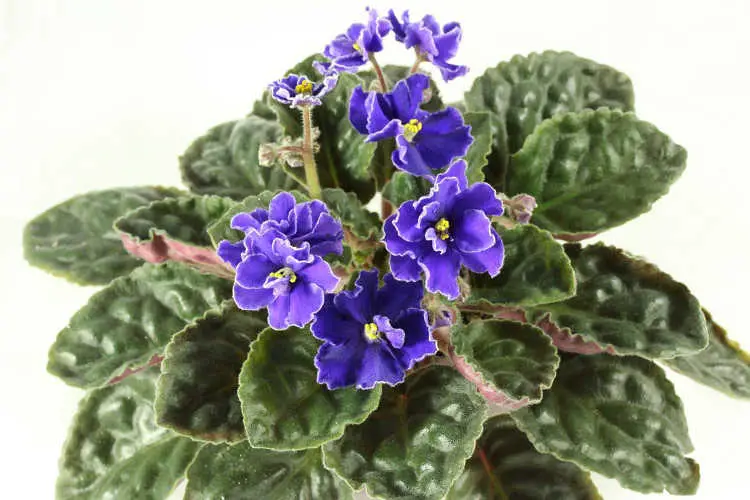 The ‘Optimara Martinique’ cultivar of African violets. Source: khufram
The ‘Optimara Martinique’ cultivar of African violets. Source: khuframVarious types of pill bugs may nibble on extremely young African violets. They don’t tend to do significant damage to older plants, they may injure the newly-forming growth. While you want pill bugs to remain in your garden, as they will eat dead and decaying plant matter, keep them away from seedlings!
Slugs are opportunistic little pests which will leave slimy trails everywhere while nibbling on all sorts of plants. African violets are not immune. Use a bait such as Garden Safe Slug & Snail Bait to get rid of them.
Collembola, also known as springtails, are a nuisance pest that feeds on decaying organic matter and on fungal growth. These strange little pests are actually a tiny hexapod rather than an insect. While they will not feed on your African violets themselves, they may breed around them… especially if there’s plenty of fungal growth for them to eat.
While springtails won’t be a danger to your plants, they may be a sign of other problems, including fungal diseases. Keep a watchful eye out for them, and if you see signs of them appearing, it’s time to consider fungicidal treatment.
The final pest which materializes around African violets is the fungus gnat. The larvae will hide in the soil near plant roots and can cause fungal diseases. The adult fungus gnats can also be disease-carriers, but they’re more dangerous because they can lay hundreds of eggs.
Using beneficial nematodes to kill off the fungus gnat larvae is a great option. These nematodes will happily live in moist conditions and will eliminate many soilbound parasites. Neem oil will keep the adults from laying eggs on your plants.
Diseases
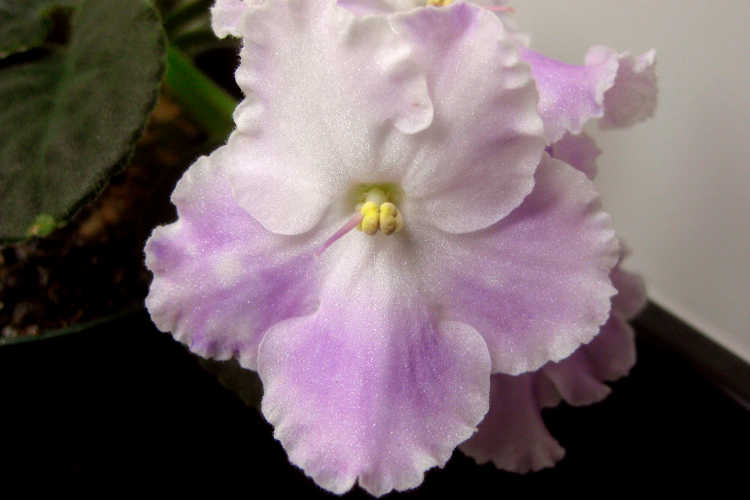 The ‘Opera’s Paolo’ cultivar of African violets. Source: Geek2Nurse
The ‘Opera’s Paolo’ cultivar of African violets. Source: Geek2NursePowdery mildew can form in highly-humid, low-ventilated environments. This white powdery fungal growth develops on the leaves and can easily spread to a number of other plants if not dealt with.
There are a lot of treatments for powdery mildew, but I personally prefer to use neem oil. The naturally-forming azdirachtin in the neem oil will cause the mildew to die out, and the oil provides some protection against further mildew. While it’ll take more applications of neem, this also protects your plant against many pests!
Phytophthora parasitica and other Phytophthora fungal diseases are quite common on African violets. These may, in fact, be the most common root rots found in saintpaulia species. Pythium is another fungal disease that produces similar symptoms to phytophthora, and it’s one of the most prevalent root rot causes worldwide.
You can rescue your plants from either of these two diseases by cutting off all diseased portions of the root and replanting in fresh, sterile potting medium as long as the disease has not reached the crown of the plant. Watch the video included in the “repotting” section above to learn how!
Rhizoctona, often referred to as damping off, occurs most often during propagation. This fungal disease causes the ends of leaf or flower stems to darken and fall off from the plant. It also causes young seedlings to wilt and die.
If rhizoctona develops in your African violet, unfortunately your best bet is to destroy that plant. Do not reuse the potting medium, and sterilize any tools or containers which the plant has been in before reusing. Avoid overly-moist environments to prevent the growth of this fungal infection.
Botrytis cinerea or grey mold is a common greenhouse fungal disease, and it is unfortunately a problem for African violets. It typically attacks the flowers and is known amongst saintpaulia growers as Botrytis blossom blight. Greyish spores will form on the flowers and sometimes on the leaves of your violets, and it will stunt plant growth.
The best protection against this fungal disease is to lower the humidity around your plant. Adding fans for good airflow can significantly help. If it still appears, use a copper fungicide like Bonide Copper Fungicide to kill off any spores.
Erwinia carotovora and Erwinia chrysanthemi are both forms of bacterial soft rots which impact African violets. These cause water-soaked spotting on leaves and wilted, rotting stems. If untreated, it will cause plant collapse.
To treat these bacterial infections, reduce the humidity around your plant to a level no greater than 60%. Keep tools sterilized so you don’t spread the infection to other plants, and don’t reuse potting soil.
Adding more nitrogen to your potting mix may help build up resistance to Erwinia. Also, spray your plant thoroughly with Bonide Copper Fungicide to kill off the bacteria that causes it.
Frequently Asked Questions
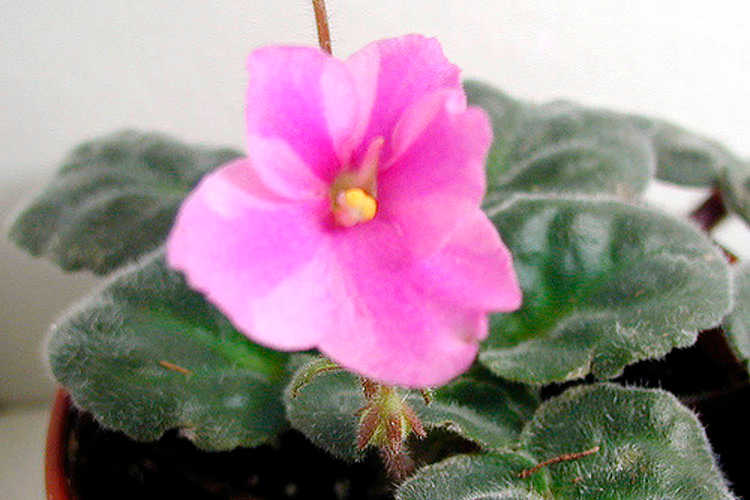 An unusual cultivar, ‘Natasja’ is a chimera – an unusual hybrid African violet. Source: Geek2Nurse
An unusual cultivar, ‘Natasja’ is a chimera – an unusual hybrid African violet. Source: Geek2NurseQ: Tell me how to make African violets bloom!
A: Slightly rootbound conditions seem to spur the African violet to produce flowers heavily. Unless your plant starts to wilt or seems super-crowded and lopsided, keep it in a smaller pot to encourage flowering.
If you want your plant to get larger, you can give it more root space. However, it’ll often stop flowering while expanding its size, so plan for it to spend its energy on growth rather than pretty flowers for a bit.
While at first African violets can be tricky to learn, once you’ve got the hang of it they’re extremely easy plants to propagate and grow. They’re great color spots indoors and out. What’s your favorite cultivar of the tens of thousands available? Share your African violet stories in the comments!

